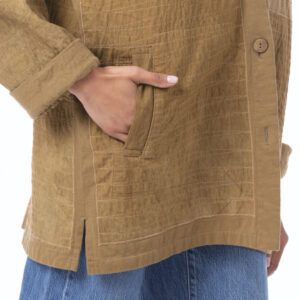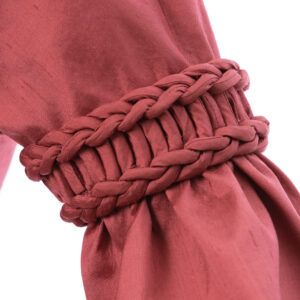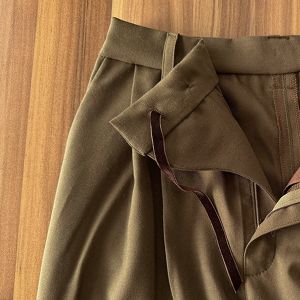Through experience and through examining RTW slacks and pants patterns, I have seen that the seat seam (a.k.a. “back crotch seam” is consistently drafted ruler straight from the bottom of the waistband to the back crotch curve. Although we might tend to think of our backsides as being curved, (therefore the seam “should be” curved), when it is curved toward the seam allowance it leaves a bubble of excess fabric and when it curves away from the seam allowance, a tight area. I have seen very few exceptions after fitting 1000’s of people.
However, I have only found one reference, in the Singer book Sewing Pants That Fit, that explicitly states that this seam should be straight. And that was only a brief comment in diagram “Relating the Pants to the Body”. Does anyone else out there with pattern drafting experience have written references on how this seam should be drafted? Anything at all?
Any comments from experienced tailors also appreciated.
Thanks,
Becks, now upstate



























Replies
I'll have to check in my book collection for specific references ;-) However, I have drafted lots of pants and was taught at school to draft a straight centre back seam from the waist to the beginning of the crotch curve. I can't imagine drafting it any other way.
I'll look for written references and get back to you.
Sandy
I wonder if curving that seam would be similar to curving a center front bodice seam. If the hips are two mounds then shaping needs to be done pointing towards the mounds? It seems that that portion of the center seam only serves to widen the silhouette from waist to hips in that area. Lower down it shapes possibly due to the angle of the fabric planes to the seam line?
Straight CB seam is certainly diagrammed in Connie Crawford's pants book -- and she comes from the RTW patternmaking world, as well as teaching patternmaking. I believe Winifred Aldrich's metric pattern cutting
also uses a straight CB seam.
If that seam isn't cut on the straight, then it's bias, which gives. Perhaps extra curves would make it uncontrollable.
I think you could control it (twill tape or such), but I suspect
that doing anatomical curves in the back seam would give you much trouble if you wanted to sit down unless you've got a much, much
smaller percentage of body fat than most women. Seems to me to be
easier and more straightforward to fit back darts (perhaps curved
back darts) instead, as I usually don't want to emphasize, um, rear
cleavage.
Sorry to have taken to long to get back to you, Becks. It has been a wild week, I'm snowed under with work, and now I'm coming down with something. Oh, well. Life goes on.
In looking through my books, I notice that some books show you the pattern drafting method as having a ruler straight centre back seam until the crotch curve, but they don't say it explicitly. I'm thinking of Helen Armstrong's "Patternmaking for Fashion Design" and Winifred Aldrich's "Metric Pattern Cutting" in particular. However, the Esmod Pattern Making Manual for Women's Garments does specify a straight cb line for both of their pant blocks. And my patternmaking manual from the International Academy of Design (in-house publication, only available to students) also states explicitly that the cb seam should be drafted with a straight line from the waistline to the beginning point of the crotch curve for their two pant blocks. Each of these books places the center back seam on differing angles depending on the rest of the draft, but the line is still straight.
Hope this helps.
You mentioned Metric Pattern Cutting and it made me curious. I have been using Helen Joseph-Armstrong's Patternmaking to learn pattern drafting. In my return to serious sewing I realized that the patterns I could buy didn't have "my" lines and I want to sew what I am thinking. It is fascinating how the numbers become shapes and how the subtelties in the shapes can change everything! I drafted a bodice and made a sleeveless top, that worked well. I just drafted basic trousers and was rewarded with a pretty nice fit in the pinned pattern. Not perfect, yet, but how fun!
I am wondering about the differences in the patternmaking "formulas" between European and American, especially for the elusive perfect pants. Would you be able to shed some light on this?
Wow! Kudos to you for learning pattern drafting on your own. It can be tough going without anyone more experienced to answer questions. I bought an early version of Armstrong's book more than ten years ago and used it to help when taking classes. But on my own, it was more than a little confusing!
When you compare European and American patternmaking books, the more obvious difference is in the basic blocks and how they fit. Most of the European books use a bodice block that has two front darts - one from the shoulder (either centred or at the neck point) for shaping the bust, and one from the waist which primarily gives waist shaping. There is also more of an emphasis on developing and using a hip length sloper.The differences in fit are quite subtle and often are a matter of personal preference. For my larger clients, I have found that Aldrich's blocks are outstanding and need far fewer adjustments for fit. She takes into account cup size (without ever actually saying it) when determining the size of the dart....it isn't just a set value, as I've seen in other books. As far as pants are concerned, it is fairly well-known that the crotch curves are quite different in European vs American patterns. The back crotch is longer (and the front shorter) on European-fit pants. I've had wonderful success with the European method I was taught at school and I use it for all of my clients. It is only rarely that I have to make corrections to the crotch area. (And that was on a size 30+ lady who was very difficult to fit!)
As far as the actual patternmaking once the block has been perfected, there really isn't that much difference. It is mainly the styles that are illustrated will be different, but the patternmaking principles are the same. You have a good foundation with the Armstrong book.
I'm not sure if I answered your question very well. Hope this helps.
Yes, thank you! You answered my question and then some. I am getting a better idea of what the differences are. You are right, it would be MUCH easier with a good teacher that could explain things, but that just isn't possible right now. Learning from a book is pleasant, but it can be quite frustrating at times too. Thanks for sharing your knowledge and experience, it is a big help!
I am curious to know if and how people in this Gatherings forum use or would use personal patternmaking slopers. I use the term slopers to refer to those boring, unstyled patterns consisting of basic patternmaking blocks without seam allowances. I am forever attempting to "push the envelope" on benefits of having well-fitted slopers to use as patternmaking templates and more.
Slopers ought to be easily acquired and fine-tuned to deal with personal figure distinctions. Once the personal sloper shapes are modified to include tweaking, they would be useful to fit other patterns and to style new ones. This would mean a major fitting project with the sloper but only minor fittings with the resulting garments.
Are people here interested in this type of sewing pattern tool or am I "barking up the wrong tree"? Any feedback would be much appreciated.
TheSloperLady
Not the wrong tree as far as I'm concerned. I use slopers both for me and for my clients. It is the first step in producing a quality pattern that fits, IMO. I'm always explaining to my customers the benefits of having a perfect sloper, usually when they first visit me to have a garment made for them. Although, to be perfectly honest, most people aren't that interested in the sloper, nor do they want to pay for the time involved....they just want to get to the garment fitting itself! I usually skip steps for customers (but not for me) and go straight to the garment muslin for the first fitting, hoping I haven't made any errors along the way. Major exception here....I ALWAYS fit a muslin sloper for pants.
Hope that helps.
Sandy
Edited to say that I may have led you to believe that I don't routinely make slopers for my customers. Quite the contrary...I simply check them over for accuracy and then proceed to the garment pattern and its muslin. I don't fit the sloper itself on the customer, though in a perfect world, I would.
Edited 8/23/2004 3:43 pm ET by Sandy
Thanks for the feedback Sandy – it was what I was hoping to hear. That mirrors my thoughts precisely.
To have one’s long-standing commitments validated is very special. Unfortunately as you’ve experienced, the subject is not of much interest. Well-fitted slopers as you agreed can be the start of any number of wonderful pre-fitted sewing projects.
How interesting (but not surprising) that you always do pant slopers. From the complications involved, we left the pant sloper until last. Then, I incorporated a pinch-tuck as used by one of the noted author/teachers on whom I have always been keen. The pants fit nicely, but the side seam has a funny little curve that doesn’t look very appealing. In the end, I didn’t have the heart to ask the programmer to remove the pinch-tuck as it had been rather tedious.
If you have a way of using a DXF drafting file, I’d be most interested to hear what you thought of our pant sloper fit. If you’re not familiar with DXF format, it is CAD (Computer-Aided Drafting – specifically for sewing patterns or not).
Let’s talk again - TSL (TheSloperLady) "Sew Smart – Fit FIRST!
I've done some CAD in the past, when I was in design school. Also, I have the Fittingly Sew patternmaking programme, though I can't say I have even begun to explore its possibilities. I have a Mac computer, so there aren't as many programmes that I can use....I'm assuming that the DXF format is for a Windows operating system.
The reason I always do a pant sloper is that the difficulty involved in fitting pants on some bodies makes it more acceptable and understandable to the customer to fit the sloper as a first step. When working on garments for myself, I always use my pre-fitted sloper as it results in far fewer fitting corrections.
I'm not sure I understand what you mean by a "pinch-tuck". Wouldn't darts make sense in fitting the pant?
Tuesday, 24 August 2004
Unfortunately you’re right Sandy. CADTERNS is for working with a Windows OS. There are a couple of programs that can be used to make Windows work with Mac, but I haven’t seen anything 1st hand and don’t know if it’s worth the bother. So too with Fittingly Sew - I’ve heard of it, but not experienced it. I regret that we’re unable to share files.
The pinch-tuck that I mentioned is at the crotch seam. Both crotch length and inside leg seam are shortened by ¼", like pinching the seam in both directions. I have been so cautious to avoid any styling temptations to influence our slopers – but this is one got away. It does fit well but does not look great.
You can see the pant online at http://www.cadterns.com/pant.htm. Our total collection of slopers is shown at http://www.cadterns.com/pro.htm
I’m sorry that we’re both on different systems. My Website address is [email protected] if you know of anyone who might be interested in our Windows compatible system, please pass our http://www.cadterns.com Website along. Someone who, like you is able to hand draft slopers would find our slopers of limited use I expect. The recreational or entrepreneurial sewer who just wishes she had your background could do great with these as "cheaters" by having instant access slopers to use either manually or digitally.
It’s been nice chatting with you.
Cheers!
Lauraline
"Sew Smart – Fit the pattern BEFORE you cut the cloth"
I'm curious about your pant sloper and will have a look at your website. I've never heard of this pinch-tuck before and it is intriguing.
I'm sorry too that we're on different systems. I've read about Cadterns and it sounds like a wonderful programme. Being able to hand draft slopers is great, but I think that for someone with my skills who also sews for other people, the programme would be more valuable than you realize. I spend a great deal of time on the slopers and, as you know, this time is rarely rewarded adequately when charging for the garment. It would be a huge reduction in workload to be able to plug a small number of measurements into the computer and be able to print out a well fitting block to design from. Not to mention the stress it would alleviate.
Thanks for making this information available. I wish you well with your business.
Thanks for confirming what I knew through experience. I'll be using your sources in an upcoming discussion with the fitters I work with. I REALLY appreciate you taking time to look this up.
Becks
Not a problem. I really didn't mind at all.
I think the darts (1-2) that usually appear in the back give the needed shaping. I am guessing that they look at it the same way as the front pieces. Down the center front, it is almost always a straight line (with exceptions having to do with the creative design). Our fronts are usually more curved than our rears. Here again, the shaping is done with darts, or the side seam is curved, depending of the fit and style involved.
Sherry G in Texas
All my research so far says you are exactly right!
Thanks,
Becks
I came across this interesting bit in the 1942 Modern Pattern Design book on the Vintage Sewing site. Fig. 2 is attached.
Shaping Center Back and Shortening Dart: If dart is shortened and straightened to fall in a parallel line with center back seam it creates a mannish effect and tends to slenderize hipline. A slight curve placed in center back seam will make garment fit feminine figure more literally. See Fig. 2. If customer's sloper has pronounced curve at side back seam, it should be traced in as draft is made and then tapering can be started from that point.
From http://vintagesewing.info/1940s/42-mpd/mpd-09.html
This post is archived.